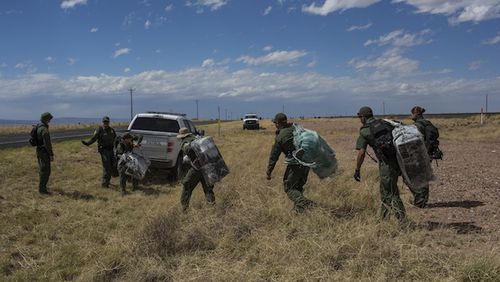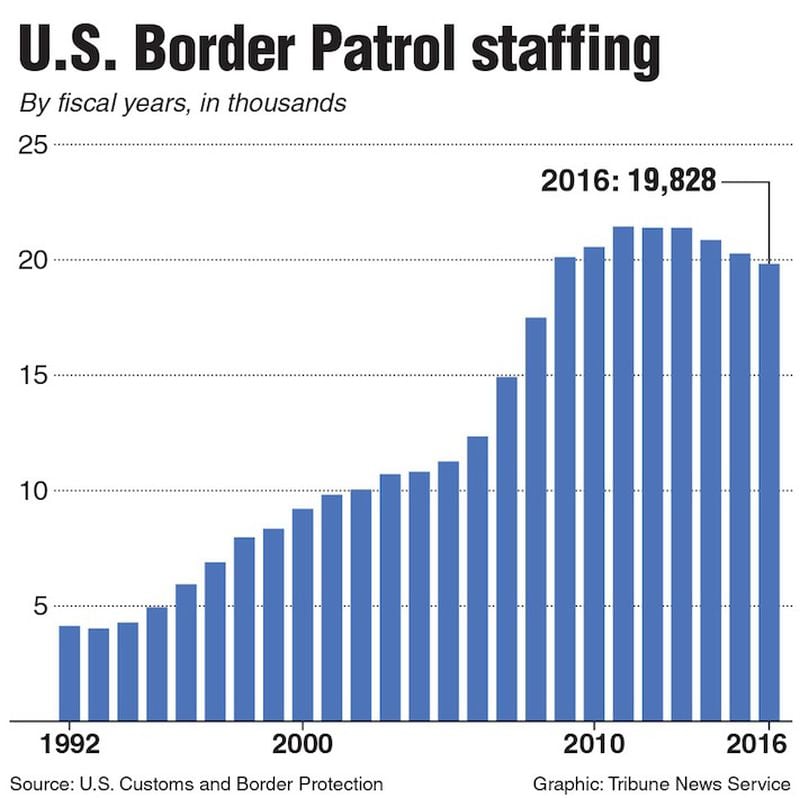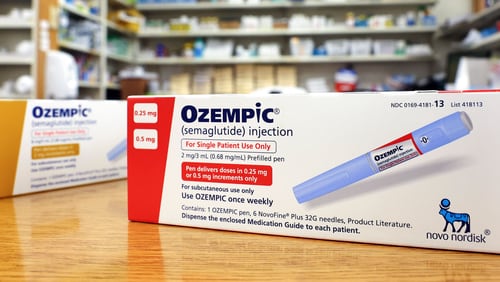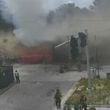President Donald Trump's promise to crack down on illegal immigration includes not only a wall but also more people behind the wall — an additional 5,000 Border Patrol agents and 10,000 immigration officers.
Those lofty goals come with a set of unknowns — such as how soon, where the money would come from — and a recent history that provides some cautionary tales.
Like the story of Oscar Ortiz Martinez.
For years, Ortiz had one goal in mind: become a federal law enforcement officer.
After a four-year stint in the Marine Corps he returned to his El Centro home in 2002, but it would take a while to achieve his dream. He worked as a security guard at a privately run immigration jail for years before he was hired by U.S. Customs and Border Protection in 2006.
At first, Ortiz had a problem joining. He was terminated in 2007 when a background check turned up a restraining order taken out by his ex-wife. Undeterred, he reapplied in 2008 and was hired.
It was a good time to join. The CBP along with its sister agency, U.S. Border Patrol, was in the midst of an unprecedented hiring spree that would lead to both agencies doubling in size between 2003 and 2009.
That rapid increase in staffing came with some problems. Hiring standards were lowered, training at the Border Patrol Academy truncated, and background checks — a crucial step — were delayed or not performed at all.
Just months after being hired, a girlfriend accused Ortiz of stalking her. And shortly after that, he became the target of a sting operation orchestrated by a federal task force focusing on border corruption. Ortiz was investigated for teaming up with a former colleague at the immigration jail to allow loads of drugs to be smuggled into the U.S. through the inspection lane he staffed at the Calexico port of entry.
In 2013, he was convicted in federal court of bribery and sentenced to 12 years in prison.
Ortiz took his place in an ignominious lineup of about 170 border law enforcement agents and officers who have been arrested, indicted or convicted in corruption cases since 2002.
Officials would later acknowledge the pressure to meet the hiring goals allowed less qualified candidates onto the force, and fueled in part a surge in the cases.
Trump's ambitious hiring goals have raised concern among some experts that the effort could lead to a repeat of the 2000s, when the push to hire set aside long-standing agency practices designed to screen out unqualified and unfit candidates.
Other concerns include how quickly a ramp-up can be achieved and the capacity of the agencies to absorb extra workers.
"We'll have to see if they've learned the lessons from the last time," said Doris Meissner, a senior fellow at the Migration Policy Institute and a former commissioner of the Immigration and Naturalization Service, since reconstituted as Immigration and Customs Enforcement.
"The core lesson is this is law enforcement, and these are agencies that have had rigorous standards over the years," she said. "You have to be in a position to be able to push back and not cut corners.
"That's not easy to do when there are pressures to build up quickly."
Customs and Border Protection, which includes the Border Patrol, is the largest law enforcement agency in the nation with about 43,000 officers and agents.
A January executive order issued by Trump would bring a 25 percent increase in staffing for the Border Patrol and would triple the number of ICE officers, from 5,000 to eventually 15,000.
In October, long before Trump's plans were announced, the inspector general for Homeland Security released a report saying that the Department of Homeland Security was slow to hire law enforcement positions.
The report showed that it took 282 days, about nine months, to hire a single Border Patrol agent. That was an improvement from 2013, when it took 420 days to hire an agent.
At ICE, it took 212 days to hire a single officer in 2015. That, too, was better than 2012 when it took 1,161 days to hire a single deportation officer.
The report pointed to insufficient staffing to support the hiring surge. In 2015, ICE had three people to process 3,000 applications for entry-level deportation officer jobs — and this was during a previous hiring surge.
In February, after the executive orders were issued calling for more Border Patrol and ICE staff, Inspector General John Roth testified to a congressional committee that DHS "will face a number of challenges" in executing the orders.
After referring to the long hiring times, he said his office would work with the agencies to help "avoid previously identified poor management practices and their negative impacts," a reference to the corruption and misconduct problems.
Although only a small fraction of the total workforce has been implicated, the slew of misconduct cases cast a pall over the agency and led to scrutiny from watchdogs, the media and Congress.
"Even one is too much," said David Aguilar, the Border Patrol chief during President George W. Bush's administration when the hiring surge was launched.
DHS has been trying to get a handle on corruption problems in its border security forces for several years. In 2014, then-Secretary Jeh Johnson convened a high-level Integrity Advisory Panel and ordered it to examine several issues, including preventing corruption.
Among the panel's early recommendations was that CBP urgently needed to add hundreds of criminal investigators to its Internal Affairs division to investigate allegations.
In its final report issued in March 2016, the panel said CBP needed 550 full-time investigators and recommended that 350 be added over the next three years.
According to the report, the agency had added only 57, with plans to add just 30 more the next fiscal year. At that pace, the panel said, it would take almost a decade to get Internal Affairs to the staffing levels it said were needed to root out corruption.
"This leaves CBP vulnerable to a corruption scandal that could potentially threaten the security of our nation," the panel wrote last year.
Credit: Davis
Credit: Davis
About the Author







